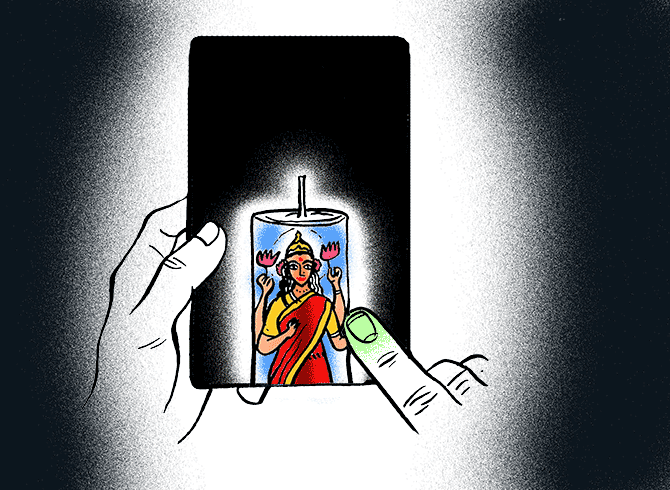‘I sat in the grass with avatars or 3D digital bodies controlled by others, reminiscing about phuljharis and chakhris, gazing up at fireworks programmed earlier in the day,’ says Ashish Sharma.
Illustration: Dominic Xavier/Rediff.com
Holidays set in for me, Diwali loomed, and a time of enforced sociability finally came upon everyone inhabiting Real Life.
Complicating Real Life further, the Supreme Court suspended cracker sales till November 1, attempting to bring down alarming pollution levels that usually take place at this time of the year in Delhi-NCR.
Being a Netizen, I knew I could slip this ban easily by buying and burning digital crackers in place of real ones, at a desi place that sees an awful lot of online traffic on Second Life virtual world around Diwali — the loneliest time of the year for cybergypsies, and the busiest time for the virtual world’s desis.
Speaking of time, it had a slow and slippery way of flowing on the desi place called Desi Beats on Second Life where Netizens gathered to celebrate the festive (and virtual) spirit of Diwali.
In the run-up to Diwali, my days in Desi Beats stuttered like dreams broken by the interruptions of Real Life (sleep, work, meals, and enforced sociability).
In my one week of holidays, I clocked fewer than 10 hours per day in the virtual world (far short of the hardcore Netizen’s typical 16), yet it felt to me as if I had already spent a lazy holiday season there.
Virtual time was in no hurry, neither was I, so I explored the virtual grounds some more, small-talked with strangers, and read casually from the Desi Beats’ public chat logs comprising daily accumulations of scandals and silliness.
And when Diwali swung near, I joined a friendly crowd in the Desi Beats backyard to watch virtual fireworks light up the midnight Second Life sky.
I sat in the grass with avatars or 3D digital bodies controlled by others, reminiscing about phuljharis and chakhris, gazing up at fireworks programmed earlier in the day by Bobby and John.
We applauded the best of the creations: A starburst of a thousand tiny diyas exploding out of a rocket, like golden rain streaking through the night sky.
There I was, not able to remember a celebration that had so amused me, feeling as if more such amusements lay ahead of me in this virtual stay of mine during holidays.
I had been around Desi Beats long enough and all the pleasant distractions with which I had been occupying myself were beginning to make me wonder: Perhaps we, the avatars, had dematerialised Diwali, using far fewer resources, deploying far less energy, and burning far less money than Real Life pomp would.
After all, this is what the Supreme Court had been hoping for, a Diwali with no ecological impact.
By bringing the culture of virtual spaces to the culture of Diwali, our celebrations differed from conventional celebrations in one crucial aspect: Ecological impact.
Sure, digital networks and hardware-supporting virtual spaces do have an ecological footprint, but the virtual consumerism that takes place inside virtual environments is different.
Virtual goods such as the fireworks described above can be created, used and dumped — all with practically negligible impact on the environment.
And why only virtual fireworks?
We can speed up the cycle of consumerism for most goods in Real Life that can be virtualised like fireworks, and yet keep the ecological impact negligible.
I say most goods because huge portions of the economy are already virtual in the sense that they serve uses that are purely mental in nature.
Firecrackers going off during Diwali, for example, excite your brain (and your brain only) no more than a thousand tiny diyas programmed to explode out of a virtual sky.
And here may lie our biggest hope for solving the ecology dilemma of the Supreme Court, and for decoupling economic growth from ecological impact.
Source: Read Full Article

